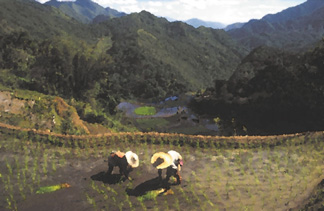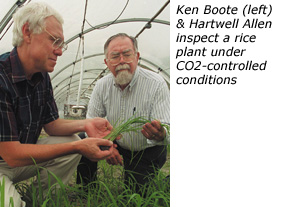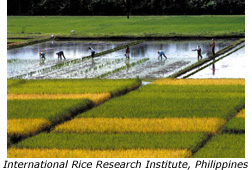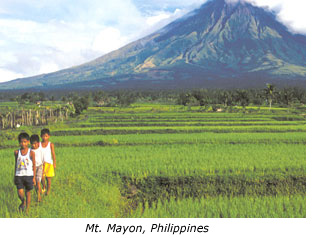Explore Magazine
Volume 6 Issue 2
 Rescuing
Rice
Rescuing
Rice
UF Research Raises Troubling Questions About The Fate Of Rice In A Warmer
World
by Aaron Hoover
If ever there was a
crop suited to the tropics, rice is it. A water-and warm-temperature-loving
grain, rice thrives in the wet-season climates of Asia and parts of Africa.
There, the flowering plant serves as the staple food for nearly 2 billion
people, more than any other crop in the world. In Cambodia, where rice
makes up 75 percent of the calories in the average diet, it is difficult
to imagine life without it. Indeed, in some Asian countries the words
for rice and food are identical.
All of this worries Ken Boote and Hartwell Allen, scientists at the Carbon
Dioxide and Climate Change Project, a joint project of the University
of Florida and the U.S. Department of Agriculture's Agricultural Research
Service.
 Global
warming - gradual heating of the Earth thought to be spurred by the burning
of fossil fuels and its greenhouse-like effect on the atmosphere - is
widely anticipated to continue during this century. The trend is expected
to be driven by an anticipated increase in carbon dioxide, the result
of fossil fuel consumption coupled with widespread deforestation.
Global
warming - gradual heating of the Earth thought to be spurred by the burning
of fossil fuels and its greenhouse-like effect on the atmosphere - is
widely anticipated to continue during this century. The trend is expected
to be driven by an anticipated increase in carbon dioxide, the result
of fossil fuel consumption coupled with widespread deforestation.
Funded largely by government agencies concerned about the impact on food
supplies, Boote and Allen have spent more than a decade studying how the
warmer temperatures and higher CO2 levels might
affect crops. They have focused on soybeans, dry beans such as kidney
beans, and rice.
The researchers' findings: While increased CO2 tends
to boost rice and other crop yields, elevated temperatures have the opposite
effect - and render rice plants totally impotent at high temperatures.
If the moderate or more extreme forecasts for temperature rise come true,
that could hurt the countries that depend most on the grain.
"I think I am worried from the standpoint of future generations,"
Boote says. "If we hit the higher side of the predictions, it's a
problem for different regions - especially the tropics, Asia and Africa."
Boote, a professor of agronomy, and Allen, a USDA and UF crop and climate
research scientist, are not alone in their conclusions, although only
a handful of other scientific groups worldwide are probing the effects
of temperature on rice and other grain crops.
John Sheehy, a crop ecologist and modeler at the International Rice Research
Institute in the Philippines, says the UF research is solid and far-reaching.
"The UF work looks very convincing to me," Sheehy says. "UF
has played a prominent role in this area and is notable for the continuity
of its efforts - the only other institution that has had a complementary
approach is the University of Kyoto in Japan."
CO2
: A Silver Lining?
Rice wasn't in the picture when the UF climate change research first started
in the mid-1980s. Instead, the focus of that early research was probing
the effects of CO2 on soybeans. To get at the question,
UF researchers designed plastic growth chambers that allowed them to control
and monitor most aspects of the plant's growing environment, pumping in
CO2 as the plants grew.
With soybeans, and later with other crops, the researchers and their colleagues
found the news is good - if increased carbon dioxide is the only change.
Worldwide, CO2 levels have increased about 31 percent
since the start of the Industrial Revolution, rising from 280 parts per
million to about 367 parts per million today. A century from now, projections
put CO2 levels at about 550 parts per million. The
biggest determining factor: What sort of corrective precautions the world's
nations agree to implement. These precautions could include reducing emissions
through cleaner power plants and cars, developing new technologies to
trap carbon underground or in the water or switching to alternative "biofuels."
Soybeans become more productive as CO2 rises, the
UF researchers found. Among the earliest such findings, the results anticipated
much more recent results with other crops. For example, research by Bruce
Kimball at a USDA Agricultural Research Service laboratory in Phoenix
has found wheat plants produce about 15 percent more grain at CO2
levels of 550 parts per million. Cotton production soars 40 percent at
similarly high levels, he has found.
Higher levels of CO2 boost yields mainly by increasing
plant photosynthesis. The increased CO2 also tends
to close the pores on the plants' leaf surfaces, resulting in increased
storage of moisture in the soil and water savings, the UF researchers
say. Thus, the relative benefits of CO2 are greatest
when the plants are water-stressed, they say.
Even rice responds well to CO2, with yield rising
as much as 30 percent more at double today's levels, Boote and Allen say.
The problem is that as CO2 increases in the atmosphere,
it produces a blanketing effect, impeding the escape of the sun's energy
from the Earth's surface back through the atmosphere to space. The result
is warmer global temperatures.
"The real question is what the CO2 is going
to do to the climate," Kimball says. "If there were no change
in the climate, then clearly we should be embracing it."
Artificial
Atmosphere
Most scientists
agree, however, that the climate is warming. In the worst-case scenario,
average global temperatures could rise nearly 8 degrees Fahrenheit by
next century, according to a report this year by the Intergovernmental
Panel on Climate Change (IPCC), the international scientific group charged
with advising governments on climate change. Some scientists have even
predicted a temperature increase of 10 degrees or higher. If emissions
are significantly reduced, the temperature increase may be 5 degrees or
less, the IPCC predicts.

Although the UF researchers did some work on the effects of temperature
on soybeans, the Department of Energy encouraged them to look at other
important crops, so Boote and Allen began to look at rice instead. They
launched their first study around 1987.
Boote is an expert in crop modeling - using computers to extrapolate what
occurs with individual plants or small sets of plants or entire crops.
To create working models for rice and climate change, he needs data not
only on yields but also on a host of other variables about how the plant
responds to a heated environment. So he and the other researchers created
a second generation of growth chambers known as soil plant atmosphere
research chambers, or SPARCs. The chambers look like large, clear terrariums,
except for an array of mechanical equipment piggybacking on each one.
As the plants grow, the equipment controls and tracks humidity, temperature
and CO2 levels. By studying these variables, the scientists are able to
deduce the rate of photosynthesis, or the process by which plants turn
sunlight and CO2 into oxygen and sugar. So precise
is the equipment that the researchers can record the crop's photosynthesis
rate every five minutes for the entire 140-day season.
"It's a state-of-the-art control of the plant environment,"
Boote says.
Although they continue to process the wealth of data from initial experiments,
the results for several different varieties of rice so far are unambiguous.
When temperatures exceeded a daily maximum of 88 degrees and daily minimum
of 70 degrees, the plants produce less rice. Yields drop 6 percent for
every degree of temperature increase through about 104-degree daily maximum
and 86-degree daily minimum, when complete failure occurs.
"Extrapolating our results, one could imagine that all rice production
could be eliminated in the tropics, although there is almost certainly
some heat tolerance in varieties not tested," Allen says.
The 88-maximum, 70-degree minimum is not a future prediction. Most tropical
regions currently exceed that range today, Bote says.
"We're on the edge now," he says.
Asian
Alarm
Elevated temperature within the ranges tested does not cripple the leafy,
or vegetative, parts of rice plants. But it does affect the plant's ability
to form seed, or grain. At relatively small temperature increases, this
occurs because the life cycle of the plant is sped up, giving it less
time to take in nutrients, process them and allocate them to seeds. At
higher temperatures, the pollination process itself begins to fail. Rice
is self-pollinating, with both male and female sexes present on each plant.
Heat tends to make the pollen, or male contribution, less viable.
The UF researchers have found that high temperatures reduce yield in tomatoes,
soybeans, rice and dry beans.
 Whether
these temperature conditions will become important depends on how much
the Earth warms and how variable the weather becomes. If the most conservative
predictions of a less-than-five-degree change turn out to be correct,
and result in a 30-percent decrease in yield, the effect may be a wash
- elevated CO2 will increase yields as much as elevated
temperature decreases them. But if the Earth continues to heat up, the
beneficial effects of CO2 will be negated. Even
a five-degree average increase would be problematic because normal variability,
such as unusually hot days, could affect rice at precisely the wrong time
in its life cycle.
Whether
these temperature conditions will become important depends on how much
the Earth warms and how variable the weather becomes. If the most conservative
predictions of a less-than-five-degree change turn out to be correct,
and result in a 30-percent decrease in yield, the effect may be a wash
- elevated CO2 will increase yields as much as elevated
temperature decreases them. But if the Earth continues to heat up, the
beneficial effects of CO2 will be negated. Even
a five-degree average increase would be problematic because normal variability,
such as unusually hot days, could affect rice at precisely the wrong time
in its life cycle.
"The pollination period is two to three weeks," Allen says.
"If you get high temperatures each day during this period, you're
not going to have much, if any, yield."
As temperature increases make rice more and more difficult to grow in
the tropics, production might shift northward to areas that are only marginal
producers now, such as northern Japan.
"If we get temperature changes of these magnitudes, there are going
to be winners and losers in the world," says Jeff Baker, a plant
physiologist who studies the effects of climate change on rice at the
USDA Agricultural Research Center in Beltsville, Md.
The problem is,
the losers would lose a lot. Asia both produces and consumes the vast
bulk of the world's rice. In 1999, Asia produced more than 540 million
metric tons of rice and consumed more than 464 million metric tons, both
topping 90 percent of the world total, according to the International
Rice Research Institute. Although the biggest producers include China
and Japan, which have cold-weather climates in some regions, most are
tropical, including Bangladesh, India, Indonesia, Myanmar and Vietnam.
And then there's the question of whether other conditions for successful
rice cultivation, including abundant freshwater, could be found farther
northward.
"Rice in Siberia - can you imagine? Is there enough water?"
Allen asks rhetorically, adding that rice could also displace other crops
now grown in northern regions.
"The tropical region will be a net loss, and globally there will
be a net loss," he says.
One possible solution
may be altering rice plants, through genetic engineering or traditional
breeding, to become more temperature resilient. If scientists could make
rice plants flower earlier in the day, for example, they might avoid the
pollination problems during the heat of the day. But Allen says such manipulation
will not be simple. The two rice varieties tested so far, one tropical
and one temperate, both crashed at the same high temperature, suggesting
that a genetic "quick fix" might be difficult to find.
Another possible solution would be to locate wild relatives of rice that
grow in very hot environments, and incorporate their tolerance to high
temperatures into productive varieties, Allen says. Baker goes a bit further,
saying it may be possible to make rice more heat tolerant by giving it
genes from other plants.
"I think we have
enough knowledge and ability to adapt to a warming climate," he says.
Still, both Boote and Allen believe the true solution is less biological
than political.
"Even though you don't really know, you would like to avoid an unpleasant
surprise if temperature goes up," Bote says. "Somebody truly
being intelligent can figure out 'How can I be more energy conserving,
use less fossil fuel and slow down temperature increases that might be
hazardous?'"
L. Hartwell Allen
USDA and UF Crop and Climate Research Scientist
(352) 392-8194
gnv.ifas.ufl.edu
Kenneth Bote
Professor, Department of Agronomy
(352) 392-1811
kjb@gnv.ifas.ufl.edu
 Global
warming - gradual heating of the Earth thought to be spurred by the burning
of fossil fuels and its greenhouse-like effect on the atmosphere - is
widely anticipated to continue during this century. The trend is expected
to be driven by an anticipated increase in carbon dioxide, the result
of fossil fuel consumption coupled with widespread deforestation.
Global
warming - gradual heating of the Earth thought to be spurred by the burning
of fossil fuels and its greenhouse-like effect on the atmosphere - is
widely anticipated to continue during this century. The trend is expected
to be driven by an anticipated increase in carbon dioxide, the result
of fossil fuel consumption coupled with widespread deforestation. Rescuing
Rice
Rescuing
Rice
 Whether
these temperature conditions will become important depends on how much
the Earth warms and how variable the weather becomes. If the most conservative
predictions of a less-than-five-degree change turn out to be correct,
and result in a 30-percent decrease in yield, the effect may be a wash
- elevated CO2 will increase yields as much as elevated
temperature decreases them. But if the Earth continues to heat up, the
beneficial effects of CO2 will be negated. Even
a five-degree average increase would be problematic because normal variability,
such as unusually hot days, could affect rice at precisely the wrong time
in its life cycle.
Whether
these temperature conditions will become important depends on how much
the Earth warms and how variable the weather becomes. If the most conservative
predictions of a less-than-five-degree change turn out to be correct,
and result in a 30-percent decrease in yield, the effect may be a wash
- elevated CO2 will increase yields as much as elevated
temperature decreases them. But if the Earth continues to heat up, the
beneficial effects of CO2 will be negated. Even
a five-degree average increase would be problematic because normal variability,
such as unusually hot days, could affect rice at precisely the wrong time
in its life cycle.